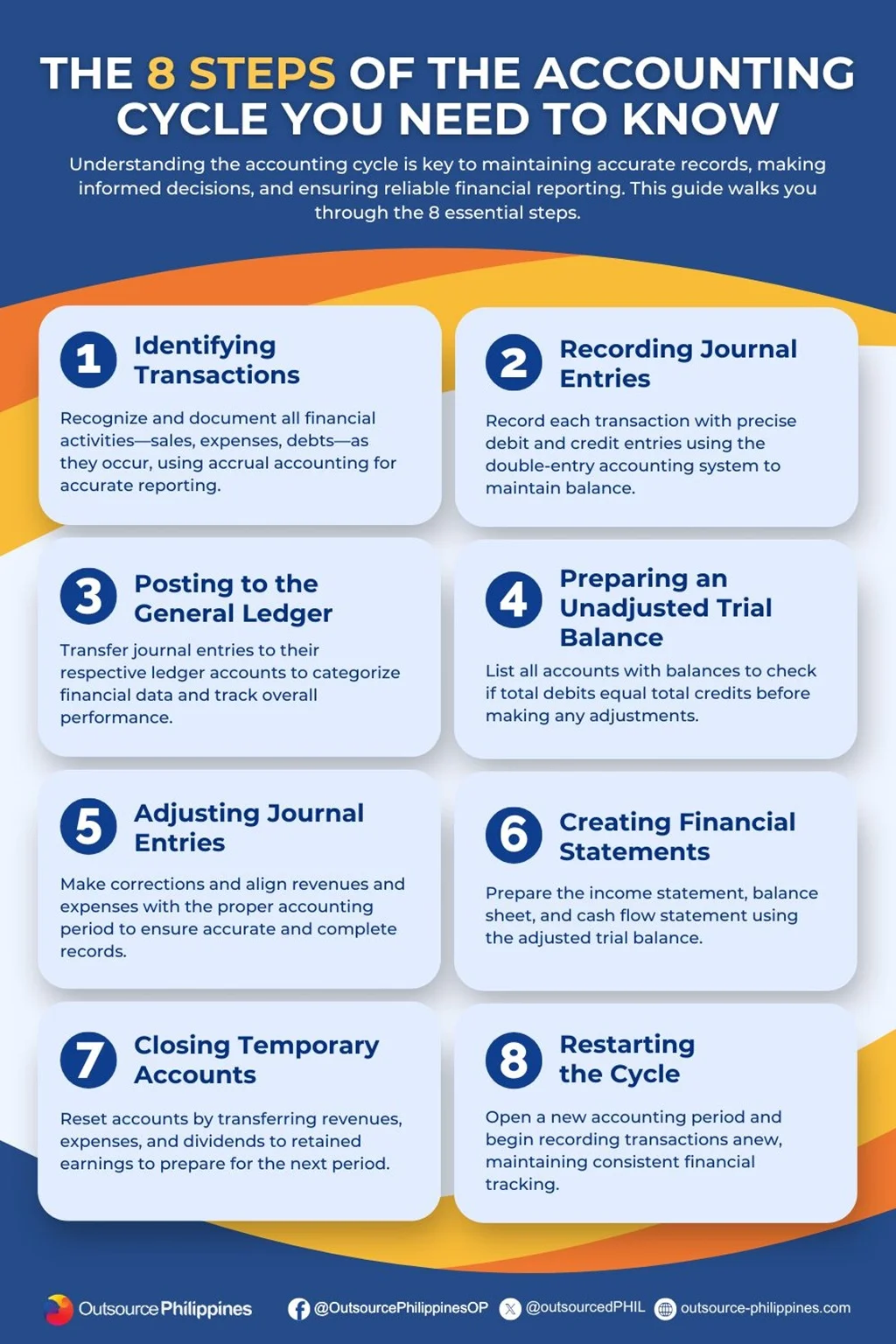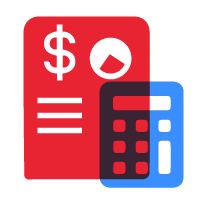Keeping your business finances in order starts with understanding the accounting cycle. This step-by-step process helps you record, organize, and track every financial transaction accurately—making sure nothing falls through the cracks. Whether you’re handling the books yourself or working with an accountant, knowing how the cycle works gives you better control and confidence in your financial decisions.
In this guide, we’ll break down the 8 key steps of the accounting cycle in simple terms. You’ll learn what each stage means, how they connect, and why they’re essential for maintaining clear, reliable financial records. Let’s dive in and make accounting a whole lot easier to follow.

Introduction to Accounting
Accounting is the way you keep track of all the money coming into and going out of your business. It helps you organize your financial transactions so you can understand what’s happening with your money. At the center of accounting is the accounting cycle, which is a set of steps that make sure every financial activity is recorded properly and in order.
The accounting cycle begins the moment a financial transaction occurs—like when you make a sale or pay a bill. You start by writing down these transactions in a journal. Then, you transfer this information to a general ledger, which is like a big, organized book that holds all your financial data. After that, you prepare important reports such as the balance sheet, income statement, and cash flow statement. These reports give you a clear view of your business’s financial situation.
Understanding the Accounting Cycle
The accounting cycle is a key process that helps you keep track of every financial activity in your business. This 8-step process gives you a clear picture of your company’s money matters over a set accounting period. Each step is important to make sure your financial records are correct and complete. The accounting cycle focuses on recording and reporting past financial transactions, which is different from the budget cycle that looks ahead to plan future spending.
At the center of the accounting cycle are the financial statements you create at the end of each cycle. These reports are essential tools for you and others who care about your business, such as:
- Management
- The Board of Directors
- Lenders
- Shareholders
- Creditors
They all rely on these statements to understand how your business is doing financially. Your accounting team plays a vital role in keeping everything organized and accurate by carefully recording and reporting all financial transactions.

8 Key Steps in the Accounting Cycle
The accounting cycle consists of eight distinct steps that guide the financial documentation process. These steps are essential for tracking and recording financial transactions, ensuring that records are accurate and complete. Following these steps diligently is crucial for maintaining accurate financial records and generating reliable financial statements.
Each step builds upon the previous one, creating a cohesive system that ensures all financial activities are accounted for and reported accurately. In the following subsections, we will delve deeper into each step, providing detailed explanations and practical tips for effective implementation.
1. Identifying Transactions
The first step in the accounting cycle is identifying and recording a company’s financial transactions. This involves recognizing all financial transactions that occur within the business. These transactions can include sales, purchases, incurred expenses, and any debts that the company takes on. It’s essential to capture every financial activity accurately to ensure comprehensive financial reporting.
Generally Accepted Accounting Principles (GAAP) typically use accrual accounting to recognize financial transactions. This means that transactions are recorded when they occur, not necessarily when cash changes hands. Documenting each transaction as it occurs ensures businesses maintain accurate and complete financial records, critical for generating reliable financial statements.
2. Recording Journal Entries
After identifying transactions, record journal entries in chronological order when recording transactions. This is a critical part of the accounting process, as it ensures that all transactions are documented systematically. The double-entry system requires that each transaction be recorded with two entries: one debit and one credit, ensuring that the accounting equation remains balanced. Additionally, it is essential to record transactions accurately to maintain the integrity of financial reporting.
Each financial transaction must include a corresponding credit to ensure accurate tracking of financial activities across multiple accounts.
For example, if a business makes a cash sale of $300, the journal entry would include a $300 debit to Cash and a $300 credit to Sales Revenue. This balanced approach ensures that all financial activities are accurately recorded, providing a reliable foundation for the subsequent steps in the accounting cycle, including cash accounting.
3. Posting to the General Ledger
The next step is to post the recorded journal entries. This is done in the general ledger. The general ledger serves to summarize all financial transactions by account, detailing overall financial activity. This step involves transferring the information from the journal entries to the appropriate ledger accounts, ensuring that all transactions are posted to the general categorized correctly.
Many accounting software solutions automate this process, providing seamless integration of journal entries into the general ledger. This not only saves time but also reduces the risk of errors, ensuring that the financial records are accurate and up-to-date. An effective accounting system can enhance these processes further.
By maintaining a comprehensive general ledger, businesses can easily generate financial statements and track their financial performance over time.
4. Preparing an Unadjusted Trial Balance
The purpose of generating an unadjusted trial balance report is to check for errors in recorded transactions. This involves listing all the ledger accounts and their balances at a specific point in time, ensuring that total debits equal total credits. A successful trial balance indicates that debit account balances match credit account balances, which is a crucial step to determine unadjusted trial balance in accurate financial reporting.
However, even if the unadjusted trial balance is balanced, other errors may still exist. Common issues include incorrect entries or missed transactions. Adjusting journal entries are made to reverse and correct any discrepancies.
This ensures accurate and complete financial records, providing a solid foundation for the subsequent steps in the accounting cycle.
5. Adjusting Journal Entries
Adjusting journal entries allocate revenues and expenses to the correct accounting periods. This step involves making adjustments to previously recorded journal entries to correct errors or allocate expenses and revenues accurately. For instance, if an error is found in a journal entry, it is corrected with an adjusting journal entry.
It is crucial to account for expenses incurred that were not recorded in the accounts payable system to ensure proper account reconciliation and financial reporting.
An example of an adjusting journal entry would be at the end of the accounting period, where the adjusting entry for Rent Expense might include a $1,000 debit to Rent Expense and a $1,000 credit to Prepaid Rent.
These adjustments align the financial records with the actual financial activities, ensuring accurate reporting.
6. Creating Financial Statements
With the adjusted trial balance in hand, the next step is preparing financial statements. These formal records summarize the financial activities of the business, providing insights into its financial health. The main types of financial statements include the income statement, balance sheet, and cash flow statement.
Financial statements are derived from the adjusted trial balance and provide a comprehensive overview of the business’s financial position. They are essential for both internal management and external stakeholders, offering a clear picture of the company’s financial statement performance and health. One of the essential financial statements is the statement of cash flows, which illustrates cash inflows and outflows categorized by operating, investing, or financing activities.
7. Closing Temporary Accounts
Closing temporary accounts is the final step in the accounting cycle. This step resets the accounts for the next period by moving transactions from temporary accounts, like revenue and expense accounts, to permanent accounts. At the end of the fiscal year, balances from these temporary accounts are transferred to permanent accounts to prepare for the new accounting period. Net income is transferred to the retained earnings account, which is important for calculating the ending retained earnings balance and impacts the balance sheet.
In the post-closing trial balance, total debits must equal total credits, ensuring the books are balanced and ready for the next accounting cycle. Closing temporary accounts allows businesses to start the new period with a clean slate, ready to record the next set of financial activities, including debits and credits. Transferring net income or loss to retained earnings, a permanent balance sheet account, is essential for accurate financial statements.
8. Restarting the Cycle For the Next Accounting Period
The final process in the accounting cycle is restarting the cycle for the next accounting period. After closing temporary accounts and preparing the post-closing trial balance, the accounting cycle resets to begin anew. This step is essential because it ensures that the financial records are ready to capture the company’s financial transactions for the upcoming period without any carryover from the previous period’s temporary accounts.
Restarting the cycle involves opening a new accounting period and beginning to identify and record fresh transactions as they occur. This continuous loop allows businesses to maintain a consistent and organized accounting process, which is critical for accurate financial reporting and analysis.

You may download a copy of the infographic above for your future reference.
Best Practices for Accounting
Implementing a robust accounting system is crucial for businesses to maintain accurate financial records. Here are five best practices to ensure the accounting cycle runs smoothly:
1. Consistently Follow the Accounting Cycle
Consistently follow the accounting cycle to accurately record and report financial transactions. This disciplined approach ensures that every transaction is captured in the correct period, providing a reliable foundation for thorough financial analysis and informed decision-making. Staying consistent helps prevent errors and omissions that could lead to misleading financial statements.
2. Use Accounting Software for Automation
Use accounting software to automate routine tasks such as invoicing, billing, and transaction recording. Automation not only saves valuable time but also significantly improves accuracy by minimizing human errors. Additionally, many accounting software solutions offer real-time updates and integration with other financial tools, enabling businesses to maintain up-to-date records and streamline their accounting processes.
3. Regularly Review and Reconcile Accounts
Regularly review and reconcile key accounts, including accounts receivable and accounts payable. This practice helps detect discrepancies, errors, or fraudulent activities early on, ensuring that the financial data remains accurate and trustworthy. Timely reconciliation also facilitates effective cash flow management and supports maintaining good relationships with customers and suppliers.
4. Train and Equip the Accounting Team
Ensure the accounting team is well-trained and knowledgeable in handling journal entries, especially for non-routine transactions and necessary corrections. A skilled team can maintain the integrity of financial records by accurately recording complex transactions and making appropriate adjustments. Ongoing training and professional development keep the team updated on the latest accounting standards and best practices.
5. Customize and Update Accounting Policies
Customize the accounting cycle to align with the specific needs of the business, such as the chosen accounting period and unique financial reporting requirements. Regularly reviewing and updating accounting policies and procedures ensures compliance with regulatory changes and adapts to evolving business operations. This flexibility enhances the effectiveness of the accounting cycle and supports accurate financial reporting tailored to the company’s goals.
By adhering to these best practices, businesses can maintain accurate financial records, support effective financial management, and achieve long-term success.
Common Accounting Errors
One of the most common accounting errors is the incorrect recording of financial transactions, which can lead to inaccurate financial statements. Ensuring that every transaction is recorded accurately is fundamental to maintaining the integrity of financial records. Failure to reconcile accounts, such as accounts receivable and accounts payable, can also result in errors and discrepancies that may go unnoticed.
Common accounting errors include:
- Incorrect recording of financial transactions
- Failure to reconcile accounts, such as accounts receivable and accounts payable
- Inconsistent application of accounting policies and procedures
- Posting errors to the general ledger
- Missing or delayed adjusting journal entries
- Errors in closing temporary accounts
- Overlooking discrepancies in trial balances
To address these mistakes, the accounting cycle involves the use of adjusting entries to correct errors and reflect any differences or discrepancies noted in reconciling balance sheet accounts. Ensuring that the accounting team is well-trained can help avoid common errors, such as incorrect posting to the general ledger.
Regularly reviewing and updating the accounting cycle is essential to ensure it functions correctly and accurately. Using accounting software to automate tasks can significantly reduce the risk of human error. Additionally, regular review and analysis of financial statements, such as the balance sheet and income statement, can help detect and correct accounting errors, ensuring accurate financial reporting and maintaining the company’s financial health.

Differences Between Accounting Cycle and Budget Cycle
Understanding the distinctions between the accounting cycle and the budget cycle is essential for effective financial management. While both processes are vital to a business’s financial operations, they serve different purposes and functions. The table below highlights the key differences between these two cycles to help clarify their unique roles in managing a company’s finances.
| Aspect | Accounting Cycle | Budget Cycle |
|---|---|---|
| Purpose | Focuses on accurately reporting past financial transactions | Designed for planning future transactions |
| Function | Provides a comprehensive overview of an organization’s financial health through financial reporting | Assists in managing operations by allocating resources and setting financial goals |
| Reporting | Produces financial statements for both internal and external reporting needs | Generally used for internal decision-making |
| Frequency | Can occur monthly, quarterly, or yearly | Typically prepared on an annual basis |
| Financial Reports | Requires management review and approval before issuance to aid decision-making and performance assessment | Budgets aid in planning and resource allocation |
| Importance | Crucial for accurate financial management and understanding past financial performance | Essential for effective financial planning and future resource management |
Timing and Frequency of the Accounting Cycle
Establishing opening and closing dates for each accounting cycle is crucial for systematic financial management. Management should set specific timeframes for each accounting cycle to align with business goals and performance analysis needs. Different businesses may have varying yearly accounting periods, such as January 1 to December 31, or alternative dates approved by the IRS.
Assessing a company’s financial position is a key objective of the accounting cycle, as it ensures an accurate representation of the business’s financial status. Closing the books at fiscal or calendar year-end restarts the accounting cycle, enabling ongoing financial performance tracking. Setting clear timeframes and adhering to them ensures accurate financial reporting and effective financial management.
Benefits of Using Accounting Software
Accounting software plays a vital role in simplifying and streamlining the accounting cycle for businesses of all sizes. By automating key processes, it enhances accuracy, saves time, and helps maintain organized financial records. Utilizing accounting software ensures that businesses can efficiently manage their financial transactions and generate reliable reports, ultimately supporting better financial decision-making and compliance.
- Automates the accounting cycle, enhancing efficiency and accuracy while significantly reducing the risk of errors.
- Provides features like automated invoicing, ensuring timely billing and helping maintain steady cash flow.
- Tracks expenses effectively, preventing cash flow issues by monitoring business costs efficiently.
- Offers automatic tax calculation to aid compliance with tax obligations.
- Enables cloud-based access to financial information from anywhere, facilitating comprehensive reporting, analysis, and easier collaboration with accountants.
Incorporating accounting software into your business operations not only simplifies the accounting cycle but also empowers you to maintain accurate financial records and respond swiftly to changing financial needs. By leveraging these technological tools, you can focus more on strategic growth and less on manual bookkeeping, ensuring your business stays financially healthy and compliant.

Common Challenges and Solutions
Staff shortages in the accounting team can hinder meeting financial reporting demands. Teams must also adapt to frequent changes in tax regulations and standards, complicating compliance. Remote work increases the risk of cybersecurity threats, necessitating robust internal controls and IT collaboration.
Additionally, understanding and managing income statement accounts is crucial for accurate financial reporting, as these accounts track revenues and expenses and are zeroed out at the end of the fiscal year. Maintaining a regular revenue account, offset by a contra account to track refunds and allowances, ensures clear differentiation between revenues and expenses in financial reporting.
Businesses can overcome these challenges by developing strategies to alleviate staffing issues and investing in training to enhance team capability and morale. Regular training on tax regulations and implementing compliance software can help manage changes in tax law. Enhancing cybersecurity measures and training employees on best practices mitigates risks associated with remote work.
Final Thoughts
The accounting cycle is more than just a series of steps—it’s the backbone of sound financial management. Embracing this process allows businesses to build trust with stakeholders by ensuring transparency and reliability in their financial records.
Beyond compliance, a well-executed accounting cycle empowers companies to make informed strategic decisions, adapt to changes, and maintain financial resilience. It serves as a vital tool that supports not only day-to-day operations but also long-term planning.
As financial landscapes evolve, staying committed to refining the accounting cycle and leveraging modern tools will be key to sustaining long-term growth and stability. Businesses that prioritize accuracy and adaptability in their accounting processes position themselves for ongoing success.
Expedite Your Financial Process with Reliable Outsourcing Solutions
Managing the accounting cycle is essential for keeping accurate financial records and understanding your business’s financial health. Each step, from recording transactions to preparing financial statements, helps ensure compliance and supports informed decision-making. Following these steps carefully can streamline your accounting and reduce errors.
To make this process easier, Outsource Philippines offers expert bookkeeping and accounting services tailored to your needs. Our skilled team handles the entire accounting cycle with accuracy and efficiency, helping improve your financial reporting and cash flow management. Partner with us to save time, reduce costs, and focus on growing your business while we take care of your accounting needs.







